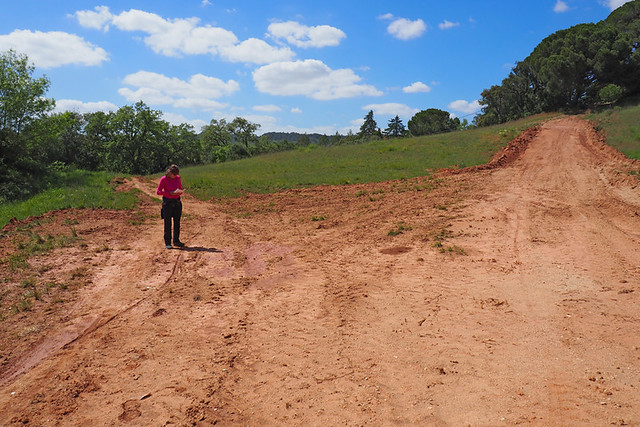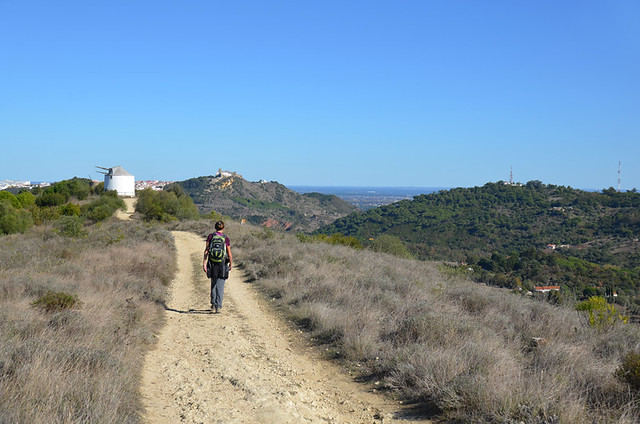It’s been a rainy week. Well more of a mix of cloud, sun and some rain really, which is rainy for this part of Portugal. It would probably be considered decent weather in some northern European countries at this time of year. We like to get in as much walking as we can during the winter months as the summer heat puts a kibosh on any decent hiking. But this week we postponed our planned walk in Arrabida Natural Park for two reasons. One is, when we know the warm, sunny weather will return in a couple of days why walk on a wet, grey day? The other is that the earthy tracks where we planned to walk are red clay. After wet weather they become an unpleasant quagmire; the clay clogging up boot treads and making soles dangerously slippery.

Ever since we took up walking in earnest, and starting monitoring weather conditions in the Canary Islands and their after effects, we’ve learned things about the weather we once would never have considered for a second. Now we don’t really do random walking, unless it’s a spontaneous jaunt from the front door. Walking expeditions, small or epic, are planned in advance, taking into account a number of factors; the weather being one.
Earlier in the year we were due to reboot a couple of Inntravel holidays on La Palma and Tenerife. The initial date proposed was at the end of March, but we pushed it to the beginning of April for one reason. March in the Canaries often ends with a bang – a storm of varying levels of intensity. It’s regular as clockwork. Sure enough, the last week of March arrived with weather alerts for heavy rain and strong winds. By contrast, when we took to the trails the weather was calm, dry, and mostly sunny. We do get lucky, but it’s calculated good luck.

Climactic change is playing havoc with the intensity of weather conditions, but there are still patterns.
We got to know some of these patterns very well in the Canary Islands. Whilst they can’t be applied exactly the same in other places, the general lessons learned have proved useful in spotting related trends in different destinations.
The perils of long, hot summers
Before living abroad we had no real concept of what average temperatures for potential holiday locations meant. The higher the better as far as we were concerned when planning which Greek Island to spend two precious weeks on.
Now we know from first hand experience that 30plus degrees is not only too hot for walking, it’s too hot for doing most things and it’s dangerous. People who don’t experience prolonged, extremely hot summers don’t always realise too hot isn’t a good thing. Whilst Tripadvisor forums for sun and sea destinations might have members excitedly commenting “I hope it stays for my visit” when they hear of a heatwave, it has locals worrying in the short term about the threat of forest fires and, in the longer term, the potentially disastrous impact of drought.

Average temperatures are mostly a meaningless measure. At best they’re a loose guideline, at worst they can be completely misleading; something else we discovered in the Canaries about weather, and weather reporting. The year round good weather tag is justified, but average temperature figures used don’t show the true reality of seasonal variations.
From a purely aesthetic point of view, long hot summers leave thirsty landscapes looking at their worst. I know, from comments about the appearance of the post-summer terrain, there are many people who don’t consider the effect summer has on a location. We enjoy walking in September in parts of Europe as the too-hot weather is on the wane and it makes for lovely, warm walking. But in southern Europe it’s probably the worst time for scenery, unless in an area which is so rich in water it remains evergreen.

Wishy washy November and the bigger picture
When summer departs and autumn breezes in, it can bring inclement weather as the seasons battle for control. Ironically, it’s a period when masses of Brits flock south in search of warmer destinations. November on Tenerife was one of the months we’d advise friends and family to stay away if they were after a week in the sun as there would be heavy rain at some point during the month. November in Portugal has proved to have similar qualities.
The annual reading of online trip reports by disappointed travellers taught me a few things about some people’s perceptions of weather. One was that they tend to consider bad ‘weather’ to be stand alone. After experiencing a storm in on Tenerife in November they might publish something like “the weather was terrible, next year I’m going to Gran Canaria” not realising the ‘terrible weather’ was as a result of a weather front which affected all of the Canarian archipelago.

It’s interesting how many folk view the weather in such a one dimensional way when it comes to holiday locations. Back home they know how weather fronts affect huge parts of their country thanks to news reports. But, generally, they don’t follow news reports in the country they’re holidaying in, so knowledge and perception of what’s going on can be severely limited.
Ultimately, travel and weather can be a complex business; one that is often viewed in measures which are too simplistic to paint a full picture; how hot will it be and will it rain?

The best time of year
At some point today the rain will stop and the sun will shine. We’ll resume our walking in a couple of days and the land will look resplendent; the grass green and perky with the wild flowers that herald the early signs of an approaching spring. Following summer the land can be ragged and unruly. As winter winds down and begins to make way for spring, the landscape blossoms and explodes into life.
Yin and yang – sun and rain; an essential partnership for a beautiful world.




Be the first to comment